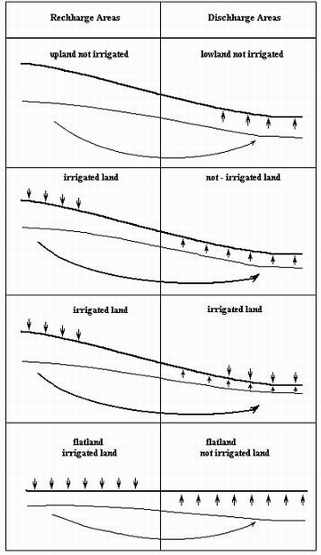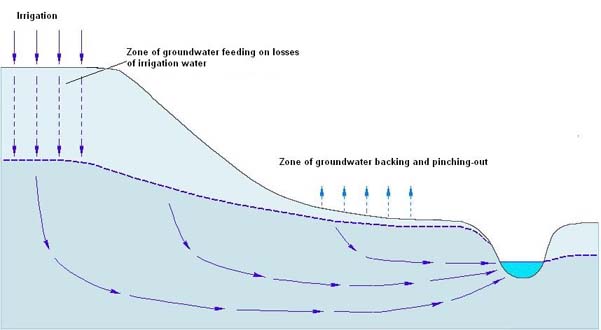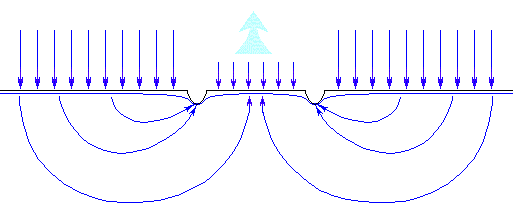Morozov
A.N.
INFLUENCE
OF IRRIGATION TECHNIQUE ON RECLAMATION STATE OF LANDS
We shall
try to clarify a question - how and upon what do various loss items
(water consumption) influence when irrigating with various irrigation
techniques.
A) Deep
discharge (DD) - by this term usually they interpret water penetration
lower design soil root-inhabited layer. Whether it is injurious or
good, if it includes (or must it include?) so called "leaching
portion", number of answers to these questions is as many as
researchers' number is.
We will consider that as a water volume in excess of design rate including
leaching component.
Under different irrigation technique DD appreciably differs qualitatively
both by spatial spreading over field area, and by desalination efficiency
of root-inhabited layer. So, DD when sprinkling is a hard-hitting
effect and it can be realized only if specially. Under furrow irrigation
DD happens at the first half of furrows owing to necessary water running
towards the end part for moistening up to adjusted rate, and it too
adversely affects general reclamation state of the territory. At that,
local pressure on down-situated territory of the field is formed and
neighboring fields because of so called "spreading knoll of groundwater"
(thanks to transfer of hydrostatic pressure). This effect is difficult
to picture on flatness, and one has to be capable to apply three-dimensional
graphics. When irrigating by flooding and filling along lines this
one becomes apparent most brightly and its consequences are very hard
to eliminate.
B) Surface
discharge (SD) is imprescriptible from all ways of surface irrigation,
and its role in irrigation erosion and worsening lands' reclamation
state due to silting exporting drain lines and collectors is difficult
to overestimate. In accordance with data of some authors, wash-away
of fruitful layer when irrigating may reach very large extents (estimated
according to fertility loss). SD can occur also under non-correct
selected rain intensity or sprinkling irrigation technology.
C) Very
disputable expense item, on which many dilettantes of science and
engineering reckon, is water consumption to evaporation when irrigating
by sprinkling. Let's attempt to consider it comparing with evaporation
when implementing irrigation by other ways in order to separate in
fact water consumption exceeding other those when undertaking irrigation
by other ways and evaluate them from standpoint of influence upon
soil reclamation state. For a start, we're going to remind water is
evaporated while absorbing warmth of 2.45 Mega-Joule/kg. This means
under water availability, factor that limiting evaporation is warmth.
Under the conditions of Central Asia's south (latitude 40 North) coming
solar radiation is able, in accordance with FAO's data, in the hottest
year's month - June to evaporate on the average 17.3 mm/day, or 173
m3/ha/day. If to take into account that under such climatic conditions
during irrigation days and first days after irrigation, water consumption
by a field irrigated by surface ways reaches an evaporation value
(i.e. similar value - 150-170 m3/ha/day), difference falling at evaporation
part in air during irrigation makes up a trifling value ridding somewhat
modified geometry of evaporating surface while sprinkling. (One can
get to know results of unusual investigations on this problem in more
details in the monograph of Vitaliy
Konstantinovich Sevryughin). Let us examine this effect
from the standpoint of influence upon the territory's reclamation
state. At first, sprinkling harshly reduce depression of plants by
hot weather; at second, water evaporating in air takes away warmth
necessary for soil moisture evaporation, in other words, as if screens
the one from evaporation. In this respect, problem of so called "efficient"
and "non-efficient" precipitation is very interesting. I
think precipitation of any size is efficient, even if that is completely
evaporated, not getting into soil, as it keeps from evaporation quantity
of soil moisture equal to itself.
But
let's suppose both the authors and FAO are seriously mistaken and,
indeed, evaporation in air when irrigating amounts to 30 % and more,
as haters of sprinkling irrigation way assert. Even in this case,
it is better to evaporate this water than to lose it at DD (which
reaches 50 % and more on highly water permeable soils) and then
to rack one's brains: how to fight against soil swamping and salinization,
and where to how to get off the brines!
Great
influence upon reclamation state of poorly drained territories is
made by overflow of water, having formed by DD under flat relief,
from irrigated and leached fields to neighboring ones. And the higher
is coefficient of land use and poorer is degree of drainage the more
serious is the problem, since in this case because of transfer of
hydrostatic pressure, alternate water delivery to any field causes
rise of mineralized groundwater on neighboring ones. That is, one
can characterize the situation as "to mill the wind". Dangerous
influence of this effect upon lands reclamation state was noted by
Averyanov S.F., Shahumjan V.A., Fedorov B.V., Mihkelson B.N.

Figure 1. The Influence of the relief and zones of the feeding
ground water on
nearby territory.
Even more
serious consequences are caused by water DD when irrigating on a locality
having big surface gradients and billowy relief as well. At this point,
such cases both increasing zones of groundwater pinch existing long
before irrigation and rise of new ones, especially during irrigating
high parts of the relief. Such effects become brightly apparent on
tapers of river carry-over, on slightly sloping and slanting submountain
plains and during irrigation of so called adyry (ostantsoviy heights)
and hilly territories. Application of perfect irrigation facilities
on such lands could solve reclamation problem on the whole on contiguous,
lower-situated territories.
Application of perfect irrigation means on such lands could
solve a few problems simultaneously:
- saving of scarce irrigation water and reduction costs to generally
unnecessary machine lifting water up to these lands;
- rise of crop yield;
- reduction by several times of needs for drainage on adjacent, lower
areas by several times;
- improvement of the ecological state of groundwater;

Figure
2. Formation scheme of zones of groundwater pinching-out on cross-country
relief of the district and, in particular, on adyrys.
By reduction of water losses at the upper part down to the minimum,
one can considerably reduce their pinching out at the lower one.
One should note the fact if using perfect irrigation technique on
adyrys or, generally, under automorpic conditions solve the problems
mentioned above, so under the conditions of semi-automorphic and hydromorphic
soils, local application of the perfect irrigation methods will be
much less efficient from the water saving standpoint. (Figure 3).
Then, one will have to supply water amount not less than on the neighboring
areas, where the perfect irrigation technique is not used; otherwise,
salinity will be inevitable thanks to subsoil overflow towards these
local sites, which will play the role of "dry drainage".

Figure 3. Scheme showing
inefficiency of local using perfect irrigation technique.
As to salt regime of the
soils and doubts regarding to that if one ought to use perfect irrigation
technique on soils subject to salinization, we will say with confidence
that any irrigation ways those improve water distribution uniformity
over a field are welcomed. More details of this you can find on the
page "Watering technique is a
key to reclamation of salted lands".
22 февраля
2004 года.
How
to get in touch with us?
Return
to the main page

